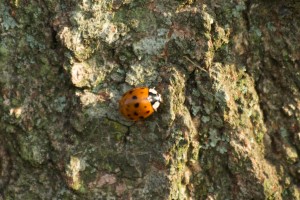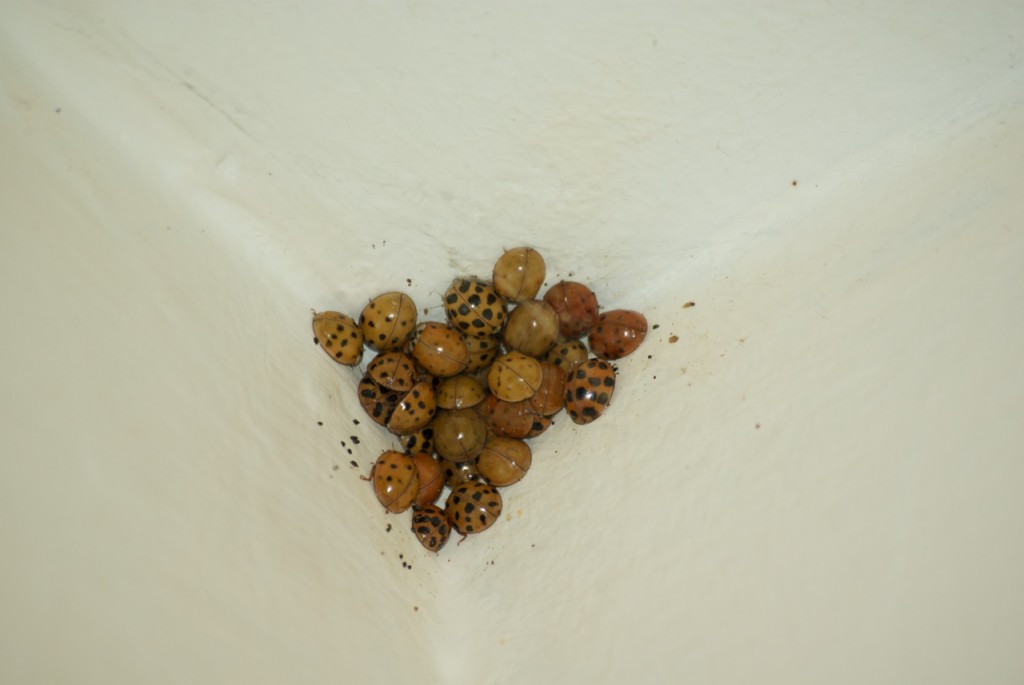They’re Everywhere! Invasion of the Lady-Bugs
“Lady-bug, lady-bug fly away home.
Your house is on fire,
your children’s alone”
When Mark Twain put this version of an old English nursery rhyme into Tom Sawyer’s mouth in 1876, he was not thinking of ridding his home of multitudes of beetles.
Particularly this autumn lady-bug beetles invaded homes, colonized ceiling corners, fouled curtains, and crunched underfoot despite repeatedly filled vacuums as homeowners tried to remove the hoards that seemed able to enter via the smallest opening. The aliens invaded.
The incursion actually began more than two centuries ago with the introduction of soybeans. Soybeans (Glycine max) originated in China and were cultivated there as a major food staple for 3000 years. In the late 1700s soybean seeds inadvertently arrived on the east coast of the United States with ship ballast in vessels plying the China trade. During the age of sail, soil – laboriously hauled by bucket brigade and dumped into ships’ holds — commonly was used as weight, but also served as an easy route for the unintended importation of numerous plants, insects, bacteria, virus and fungi.
Initially, soybeans didn’t make a big economic hit in America. From the early 1800s they were grown hither and thither in small plots and largely used as animal fodder. Soybeans were first cultivated in Illinois in 1861.
The start of the era of processed foods during the years immediately after World War II was the beginning of the explosion of soybean production. Soybeans and their rotation crop, field grade corn #2 – King Corn – together provided all the necessary sugars, starches, proteins and fats to launch, grow and sustain the multi-billion dollar agribusiness we see today. The U.S. now grows 50% of the world’s soybean crop. Illinois, in 2008, produced 500,000,000 bushels of beans valued at $4 billion.
As with many pea plant family members, soybeans are relatively untroubled by many insect pests. But, in 2000, seemingly out of the blue, an insect threat appeared. A soybean aphid species (Aphis glycines) native to China mysteriously appeared in the soybean fields of northernmost Illinois. Aphids, or plant lice, are minute — most of them less than one-tenth of an inch long – soft-bodied insects that suck plant juices and serve as a vector for a host of viruses and fungi.
Approximately 4400 species of aphid currently are known from the world but of these only about 250 pose serious threats to agricultural or horticultural practices. Aphids live in large colonies and reproduce rapidly, despite an individual lifespan that averages one month. Male aphids are extremely rare and generally are found only in the autumn when mating may occur. Mated females lay eggs that overwinter to produce next year’s population. During most of the warm season, unmated females reproduce by parthenogenesis – nature’s version of cloning — giving birth to living young, nearly all of which are females. Since each female can produce 80 to 100 living daughters, each of which also quickly reproduces, aphid colonies very quickly explode in numbers.
Aphids can be found on all kinds of plants. Their anal secretions, called honeydew, contain significant amounts of sugars and often attract the caring attention of ants that enjoy eating the sticky secretions. Ants often defend and protect aphids and will even ferry individuals from plant to plant to ensure steady diets for both aphids and ants. Generally aphids and, hence, the damage they do to plants are kept in check by a host of natural predators. The most important aphid hunter is the group of beetles known as lady-bugs, or lady beetles.
Of the approximately 400 species of lady beetle in the U.S., nearly all are considered helpful insects, with only the Mexican Bean Beetle considered a serious pest due to its vegetarian diet that focuses on bean plants. Lady-bugs, as we most commonly call the familiar red-orange colored and black spotted beetles, can be seen in gardens, lawns, woodlands, and fields as they go about their business of hunting and killing wide varieties of insect pests. Their ravenous insect carnivory has long made lady-bug beetles a favored friend to gardeners, farmers and, particularly, organic growers, who find the beetles a natural ally that keeps plants healthy by consuming mealy bugs, scale insects and, most helpfully, aphids.
The soybean aphid outbreak during the last decade was rapid, expansive and remains very costly. By 2003 the Chinese soybean aphids had spread across the U.S. By 2007, these aphids infested 89% of the 64 million acres of soybean fields planted nationwide and caused hundreds of millions of dollars in crop damages.
A quick study of the alien aphid invasion disclosed a third non-native co-conspirator in this unfolding story of foreign intrigue. The autumn generation of mated females of this particular aphid species favors Buckthorns for egg laying. This family of small shrubs is found mostly in the corn-soy belt of North America. Common Buckthorn (Rhamnus cathartica), the most favored egg-laying location for Chinese soybean aphids, is a Eurasian plant introduced as a garden ornamental. Just as with many non-native plants, common buckthorn has escaped from cultivation and now is invasive throughout much of northern Illinois. Each spring the over-wintered eggs of Chinese soybean aphids hatch on the now ever-present common buckthorns and then quickly move to soybean fields for a season of plant-juice sucking and explosive population growth.
Closing the circle on this story of foreign invasion brings us to the beetles that trooped across our windowpanes and collected along our ceilings this fall, for these lady-beetles, too, are non-natives. Multi-colored Asian lady-beetles (Harmonia axyridis), not our native lady-bugs, filled vacuum cleaners this autumn as everyone tried to rid themselves of the irritating hoards of these rasping-mouthed home breakers.
This species of lady-beetle was introduced by the U.S. Department of Agriculture in the southeastern U.S. during the mid-1980s in hopes of combating an aphid infestation of pecan plantations. The experiment seemed to be a failure, with only limited reductions in aphid damage to the pecan crops. But Harmonia lady-beetles already had escaped from the experimental fields. Within 10 years, thriving colonies were discovered in Louisiana.
The outbreak of Asian soybean aphid certainly provided Harmonia lady-beetles with a ready, and, to them, a native food source and now Harmonia lady-beetles swarm throughout most of the U.S. Unfortunately, Harmonia lady-beetles do not seem to be particularly successful at reducing Asian soybean aphid populations so that crop damage is inhibited.
But, as with most non-native invasive species, the introduction of Harmonia lady-beetles continues to have unintended, but, perhaps, highly damaging consequences. They are out-competing many species of our native lady-bugs. The yeoman’s service our native lady-bugs provide to gardener and farmer alike by predating numerous insect pests may be reduced as our native lady-bug populations decline.
The Multi-colored Asian lady-beetles and their part in this story of foreign intrigue complete with co-conspirators emigrating across continents and centuries is unfortunately one that could be repeated with numerous other species as stand-ins for this cast of characters. In nearly all cases the beginning of the story is as familiar as the ending. The easy, low-cost, seemingly well-purposed introduction initially viewed as a cure-all turns out to not actually perform well and then goes on to have deleterious effects.
Tinkering with nature – a perennial American pastime for easy-labor fortune-seekers – continues to serve up results far beyond the intentions.
Clifftop, a local nonprofit organization, is focused on preserving and protecting area bluff lands.
A version of this article appeared in the December 4 2009 edition of the Monroe County Independent.
© 2009 all content rights reserved, Clifftop NFP.
Comments are currently closed.



